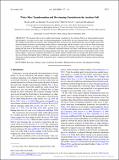Water mass transformation and overturning circulation in the Arabian Gulf
Author(s)
Al-Shehhi, Maryam R; Song, Hajoon; Scott, Jeffery; Marshall, John
DownloadPublished version (3.015Mb)
Publisher Policy
Publisher Policy
Article is made available in accordance with the publisher's policy and may be subject to US copyright law. Please refer to the publisher's site for terms of use.
Terms of use
Metadata
Show full item recordAbstract
<jats:title>Abstract</jats:title><jats:p>We diagnose the ocean’s residual overturning circulation of the Arabian Gulf in a high-resolution model and interpret it in terms ofwater-mass transformation processes mediated by air-sea buoyancy fluxes and interior mixing. We attempt to rationalise the complex three-dimensional flow in terms of the superposition of a zonal (roughly along-axis) and meridional (transverse) overturning pattern. Rates of overturning and the seasonal cycle of air-sea fluxes sustaining them are quantified and ranked in order of importance. Air-sea fluxes dominate the budget so that, at zero order, the magnitude and sense of the overturning circulation can be inferred from air-sea fluxes, with interior mixing playing a lesser role. We find that wintertime latent heat fluxes dominate the water-mass transformation rate in the interior waters of the Gulf leading to a diapycnal volume flux directed toward higher densities. In the zonal overturning cell, fluid is drawn in from the Sea of Oman through the Strait of Hormuz, transformed and exits the Strait near the southern and bottom boundaries. Along the southern margin of the Gulf, evaporation plays an important role in the meridional overturning pattern inducing sinking there.</jats:p>
Date issued
2021Department
Massachusetts Institute of Technology. Department of Earth, Atmospheric, and Planetary SciencesJournal
Journal of Physical Oceanography
Publisher
American Meteorological Society
Citation
Al-Shehhi, Maryam R, Song, Hajoon, Scott, Jeffery and Marshall, John. 2021. "Water mass transformation and overturning circulation in the Arabian Gulf." Journal of Physical Oceanography, 51 (11).
Version: Final published version